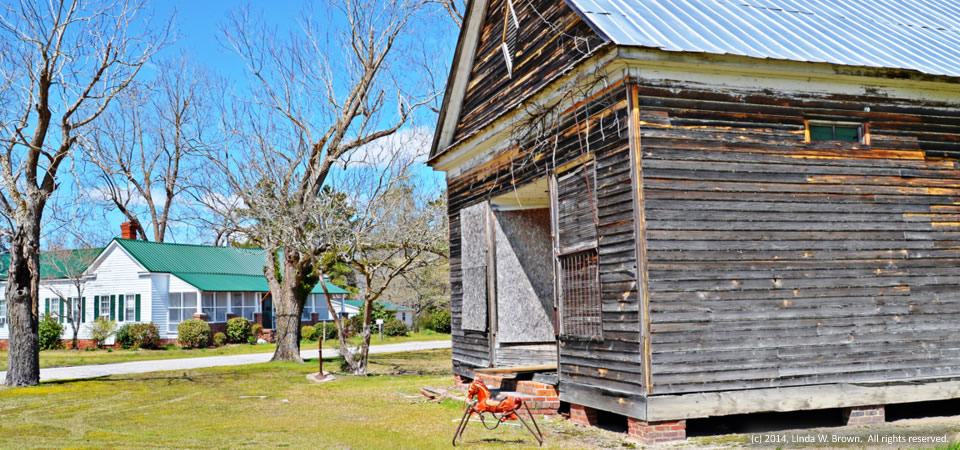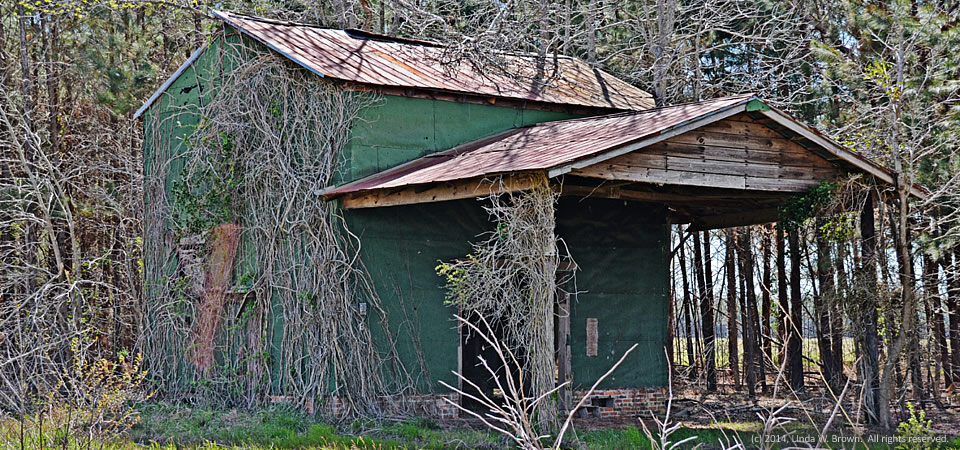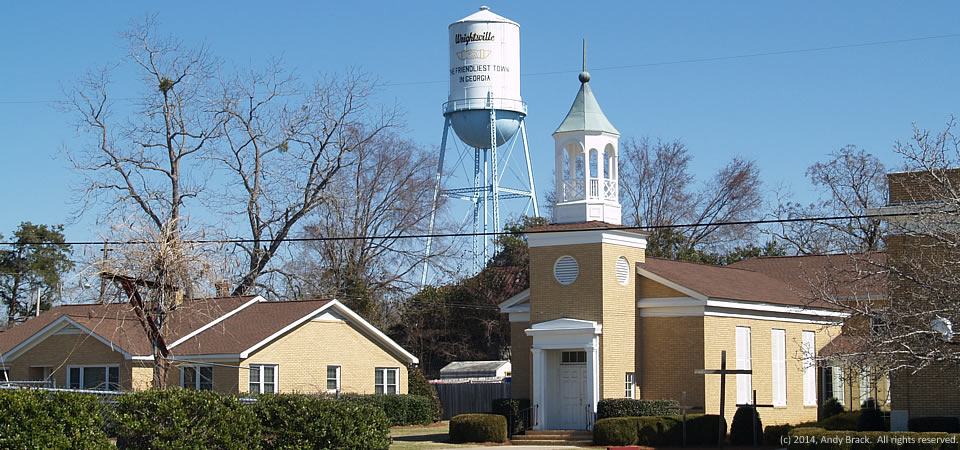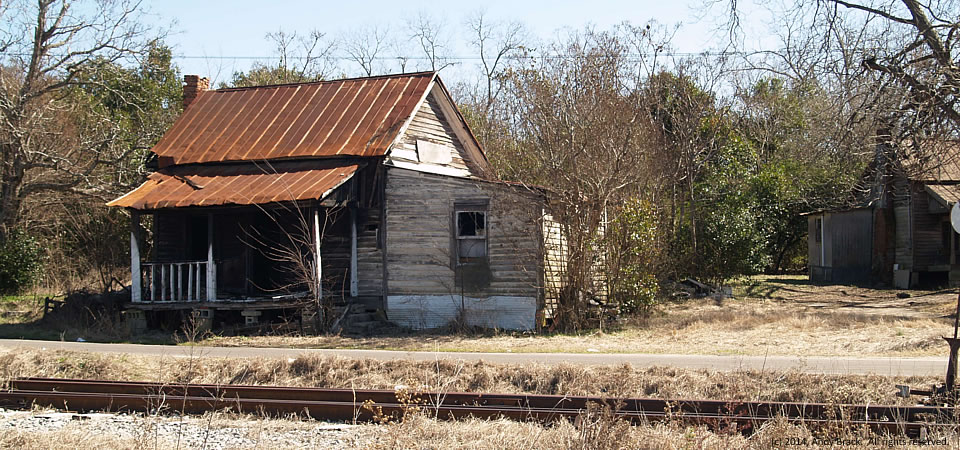An irrigation rig stands ready to supply water to crops during the hot growing season on SC 527 in Clarendon County.
Photo taken Marcy 30, 2014 by Linda W. Brown. All rights reserved.
The late U.S. District Judge J. Waties Waring of Charleston, S.C., is being honored Friday with a statue that is a fitting remembrance for his huge role in ending segregation.
Waring became a social outcast in the late 1940s and early 1950s for civil rights rulings which culminated with a dissent in Briggs v. Elliott from rural Clarendon County, a Crescent county today. Waring’s dissent is notable because it became the backbone for the landmark Brown v. Board of Education in 1954 that ended segregation in public schools.
Photo by Michael Kaynard. All rights reserved.

Kingstree, S.C., photographer Linda W. Brown found an old country store, a vintage rocking horse and a restored farmhouse standing within yards of each other at Workman Crossroads in western Williamsburg County.
Williamsburg County, which is about 75 miles north of Charleston, S.C., has a population of just under 34,000 people. Population peaked in 1950 at 43,807, but has dropped slowly since then.
About two-thirds of county residents are black, with almost all of those remaining being white. Only 2 percent of those in the county are of Hispanic descent. Some 32.8 percent of residents live in poverty, according to the Census. Of the county’s 1,921 firms, 36.5 percent are black-owned — a percentage that is three times South Carolina’s average.
Photo taken March 30, 2014, by Linda W. Brown. All rights reserved.

An old tobacco barn, still standing on McIntosh Road in Williamsburg County, has given way to less production and new methods of processing what is grown, retired Kingstree editor and photographer Linda W. Brown observed recently.
Williamsburg County, which is about 75 miles north of Charleston, S.C., has a population of just under 34,000 people. Population peaked in 1950 at 43,807, but has dropped slowly since then.
About two-thirds of county residents are black, with almost all of those remaining being white. Only 2 percent of those in the county are of Hispanic descent. Some 32.8 percent of residents live in poverty, according to the Census. Of the county’s 1,921 firms, 36.5 percent are black-owned — a percentage that is three times South Carolina’s average.
Photo taken March 30, 2014, by Linda W. Brown. All rights reserved.
This old farmhouse in the Sardinia community in rural Clarendon County seems to be getting a little long-needed loving. Retired editor and photographer Linda W. Brown of Kingstree, S.C., noted how the scaffolding across the house’s front porch indicates it is getting a new lease on life.
Clarendon County has 34,357 people, according to the U.S. Census Bureau’s 2012 population estimate. About half of the county’s residence are white; the other half are black. Some other statistics:
Copyrighted photo is by Linda W. Brown; taken March 30, 2014. All rights reserved.
Just looking at this photo of an abandoned bus and a creepy row of dried corn stalks gives us the Willies. It’s part of Haunted Montrose, a seasonal attraction in the small Laurens County town of Montrose, population 154.
In the bigger picture, however, what’s interesting is how folks in this small community put the town on the map in a non-agricultural time of the year to generate extra revenue. See earlier photo.
Montrose, located in central Georgia, has a relatively low poverty rate of 11.2 percent, although 30 percent of its children live in poverty. Some 23.6 percent of residents of Laurens County (population 48,434) live in poverty, according to Census data
Photo taken Feb. 16, 2014 by Andy Brack. All rights reserved.
This old Cadillac hearse in Montrose, Ga., advertises a clever local success — a ghoulish Halloween sensation called Haunted Montrose. What apparently happened is some local residents took an abandoned house in the small Laurens County town and converted it into a spine-chilling attraction open a few days each year. Just walking around the area, which has a creepy corn field, abandoned vehicles and more, might give you the Willies.
But from another perspective, it’s an interesting way in which a small community — 154 people — has put itself on the map in a non-agricultural time of the year to generate extra revenue. On April 2: Another photo from Haunted Montrose.
Montrose, located in central Georgia, has a relatively low poverty rate of 11.2 percent, although 30 percent of its children live in poverty. Some 23.6 percent of residents of Laurens County (population 48,434) live in poverty, according to Census data
Photo taken Feb. 16, 2014 by Andy Brack. All rights reserved.
At one of the main intersections in Montrose, Ga., sits this abandoned brick shell of a building that is across the street from the Montrose Baptist Church along U.S. Highway 80.
The building had few clues as to its past use, but it may have been part of an agricultural business, such as a farm supply store.
Montrose, located in rural Laurens County in central Georgia, is home to 154 people and a relatively low poverty rate of 11.2 percent, although 30 percent of its children live in poverty. Some 23.6 percent of residents of Laurens County (population 48,434) live in poverty, according to Census data
Photo taken Feb. 16, 2014 by Andy Brack. All rights reserved.

Wrightsville, Ga., bills itself as the “friendliest town in Georgia,” as highlighted by the town water tower near Brown Memorial Baptist Church on Vally Street.
Wrightsville, county seat for Johnson County in east middle Georgia, is home to about 2,200 people, 35 percent of whom live in poverty. Some 46 percent of the town’s residents are white; 53 percent are black.
Johnson County, part of the Dublin Micropolitan Statistical Area, has just under 10,000 people, 21 percent of whom live in poverty.
Photo is copyrighted 2014 by Andy Brack. All rights reserved.

Here’s a shot of another shack along the railroad tracks in Wrightsville, Ga., which bills itself as the “friendliest town in Georgia. Earlier photo.
Wrightsville, county seat for Johnson County in east middle Georgia, is home to about 2,200 people, 35 percent of whom live in poverty. Some 46 percent of the town’s residents are white; 53 percent are black.
Johnson County, part of the Dublin Micropolitan Statistical Area, has just under 10,000 people, 21 percent of whom live in poverty.
Photo is copyrighted 2014 by Andy Brack. All rights reserved.